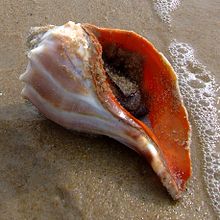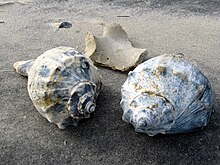| Knobbed whelk | |
|---|---|

| |
| A live individual of Busycon carica at low tide at Bethany Beach, Delaware | |
| Scientific classification | |
| Domain: | Eukaryota |
| Kingdom: | Animalia |
| Phylum: | Mollusca |
| Class: | Gastropoda |
| Subclass: | Caenogastropoda |
| Order: | Neogastropoda |
| Family: | Busyconidae |
| Genus: | Busycon |
| Species: | B. carica
|
| Binomial name | |
| Busycon carica | |
The knobbed whelk (Busycon carica) is a species of very large predatory sea snail, or in the US, a whelk, a marine gastropod mollusk in the family Busyconidae, the busycon whelks.
The knobbed whelk is the second largest species of busycon whelk, ranging in size up to 12 in (305 mm).[2]
It is the only extant species in the genus Busycon.
Distribution
Knobbed whelks are native to the North Atlantic coast of North America from Cape Cod, Massachusetts to northern Florida. This species is common along the Georgia coast. It is the state shell of New Jersey and Georgia.
Shell description


The shell of most knobbed whelks is dextral, meaning that it is right-handed. If the shell is held in front of the viewer, with the spiral end up and the opening facing the viewer, the opening will be on the animal's right side. The shell is thick and strong and has six clockwise coils. The surface is sculpted with fine striations and there is a ring of knob-like projections protruding from the widest part of the coil. The color is ivory or pale gray, and the large aperture (the inside of the opening) is orange. The canal inside is wide and the entrance can be closed by a horny oval operculum.[3][4]
Habitat
The knobbed whelk lives subtidally and is migratory, alternating between deep and shallow water, depending on the time of year.
During the weather extremes of the summer and winter months, these sea snails live in deep water, at depths of up to 48 m. In the milder weather of the spring and fall they live in shallow water, on near-shore or intertidal mud flats and sand flats.
On the shallow-water mud flats whelks prey on oysters, clams, and other marine bivalves.
They wedge a bivalve open using the edge of their shell, and insert their long proboscis to eat the flesh of their victim. They rasp at the flesh using their radula, a rough tongue-like organ that has thousands of tiny denticles (tooth-like protrusions).
Knobbed whelks are slow moving odour-mediated predators that have a considerable ability for temporal integration of signals and can successfully navigate prey odour plumes in naturally turbulent environments.[5]
Reproduction

Mating and egg laying occur during the spring and fall migration. Internally fertilized eggs are surrounded by a transparent mass of albumen, a gel-like material, and are laid in protective flat, rounded egg capsules joined to form a paper-like chain of egg cases, commonly called a "Mermaid's Necklace". On average each capsule contains 0–99 eggs, with most strings having 40–160 capsules. After laying their egg cases, female knobbed whelk will bury one end of the egg case into the substrate, thus providing an anchor for the developing fertilized eggs and preventing the string of egg cases from washing ashore where it would dehydrate. Fertilized eggs develop in the capsules. Young emerge with a shell approximately 2–4 mm in length.
Young are preyed upon by crustaceans, horseshoe crabs, and fish, primarily drum species. Adult whelks are eaten by loggerhead sea turtles.
Human use
As with conchs, the knobbed whelk is used by humans as food in such dishes as salads (raw), burgers, fritters, and chowders.
As is also true of conch shells, the shell of the knobbed whelk can be made into a natural bugle by cutting off the tip of the spire in order to form a mouthpiece.
Historically, American Indians used the knobbed whelk as a component in wampum, the shell beads exchanged in North America for trade.[6]
References
- ^ Busycon carica (Gmelin, 1791) World Register of Marine Species. Retrieved 2011-11-28.
- ^ Busycon carica Gmelin, 1791 Smithsonian Marine Station at Fort Pierce. Retrieved 2018-12-01.
- ^ Knobbed Whelk: Shell Money Retrieved 2011-11-28.
- ^ "Anatomy of the knobbed whelk". Archived from the original on 2005-04-02. Retrieved 2020-02-18.
- ^ Wilson, Miranda L.; Weissburg, Marc J. (2012). "Temporal and spatial sampling strategies maintain tracking success of whelks to prey patches of differing distributions". Animal Behaviour. 84 (6): 1323–1330. doi:10.1016/j.anbehav.2012.08.024. S2CID 53174907. Retrieved 26 April 2023.
- ^ White, Richard (1991). The Middle Ground. New York: Cambridge University Press. p. 97. ISBN 9781139495684.








